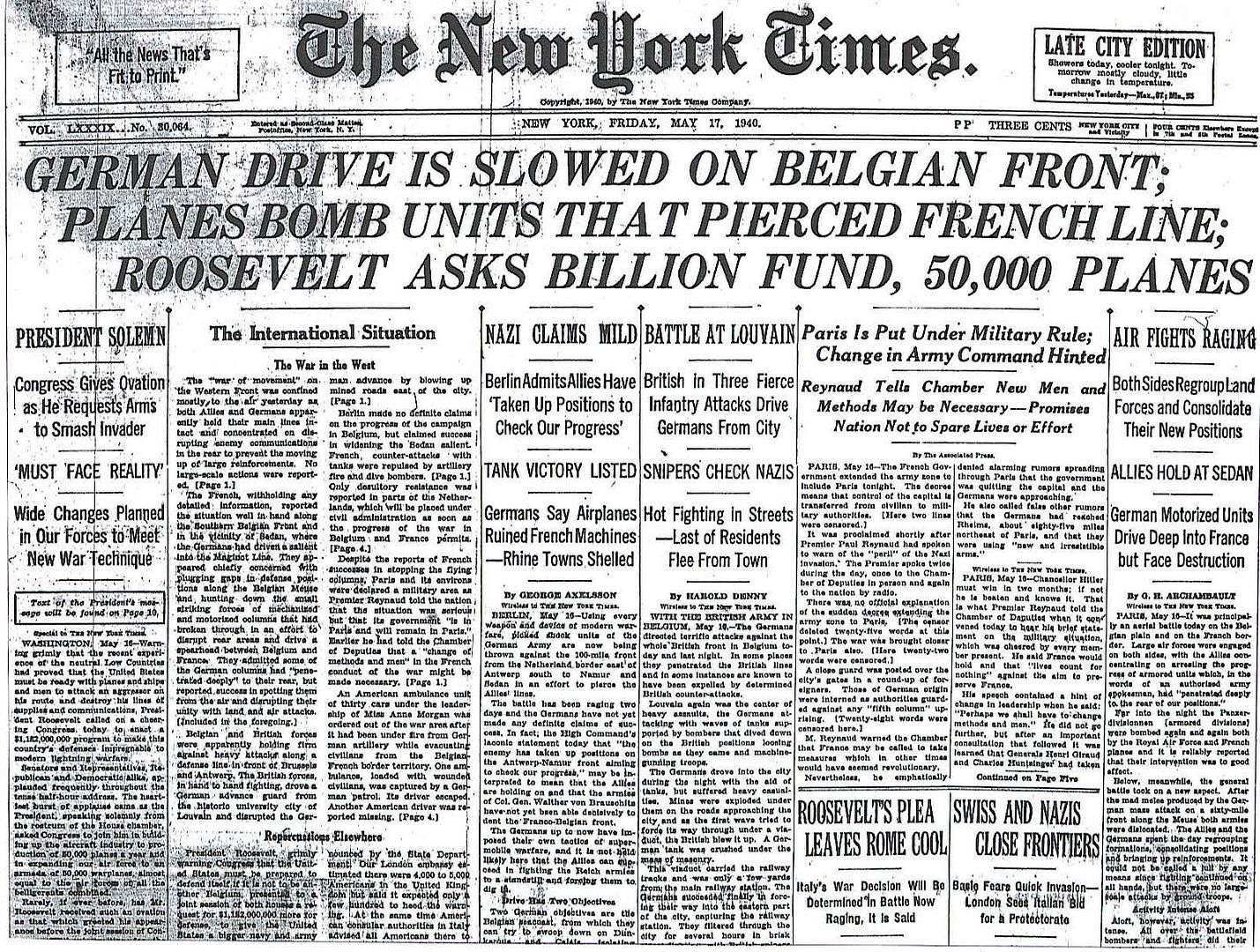
Posted on 05/17/2010 5:34:52 AM PDT by Homer_J_Simpson

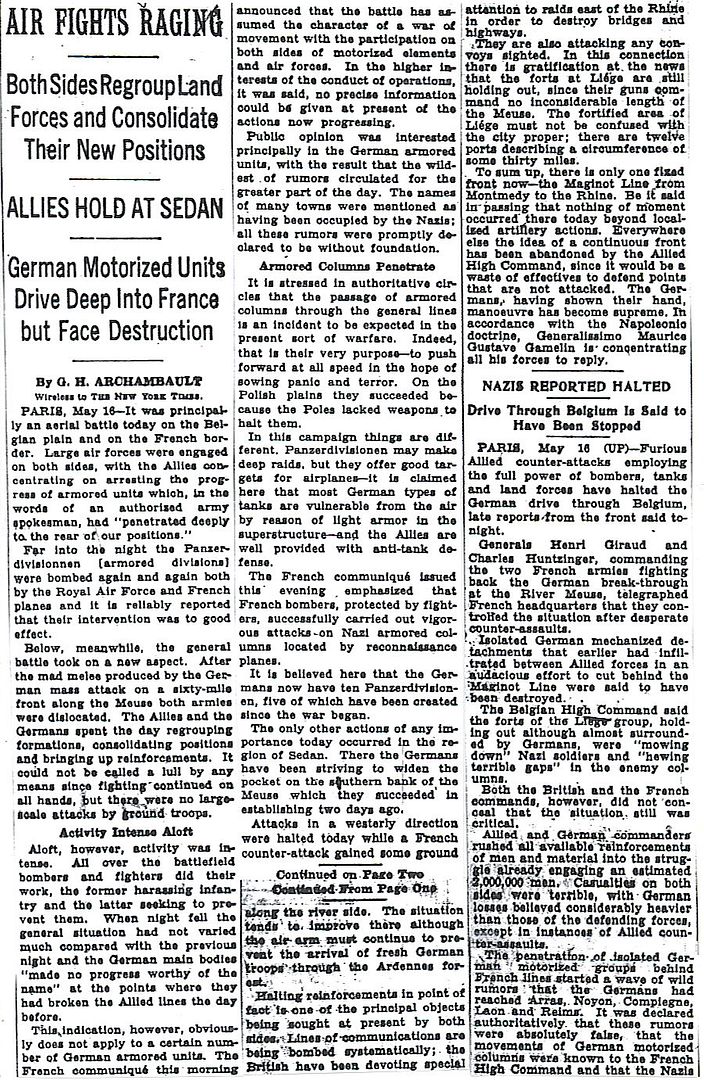
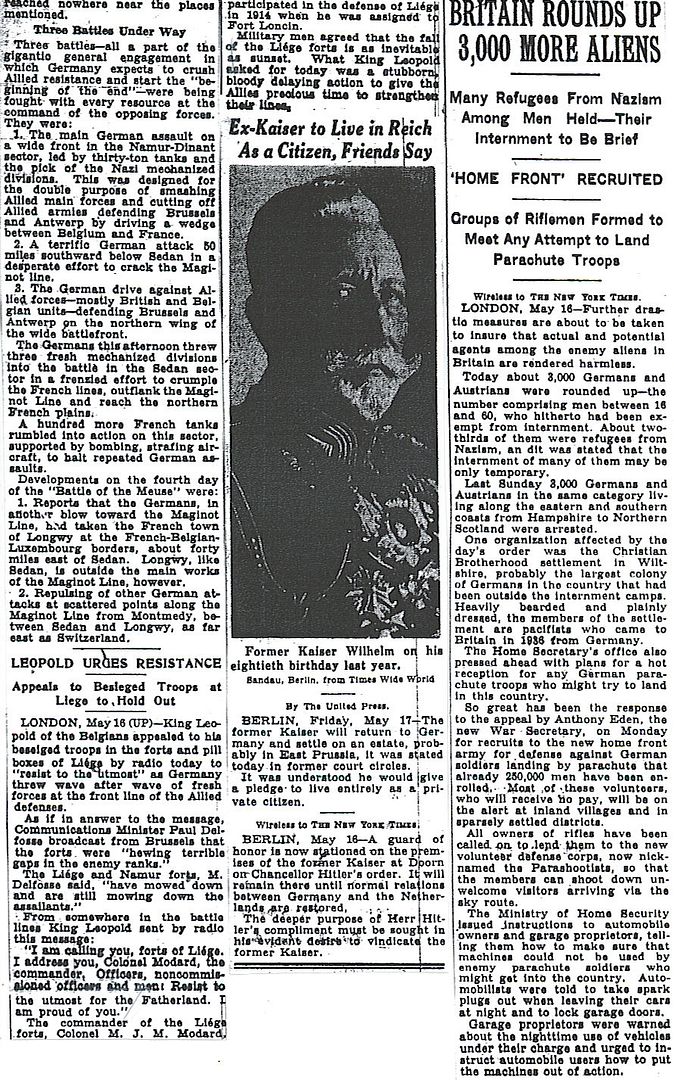
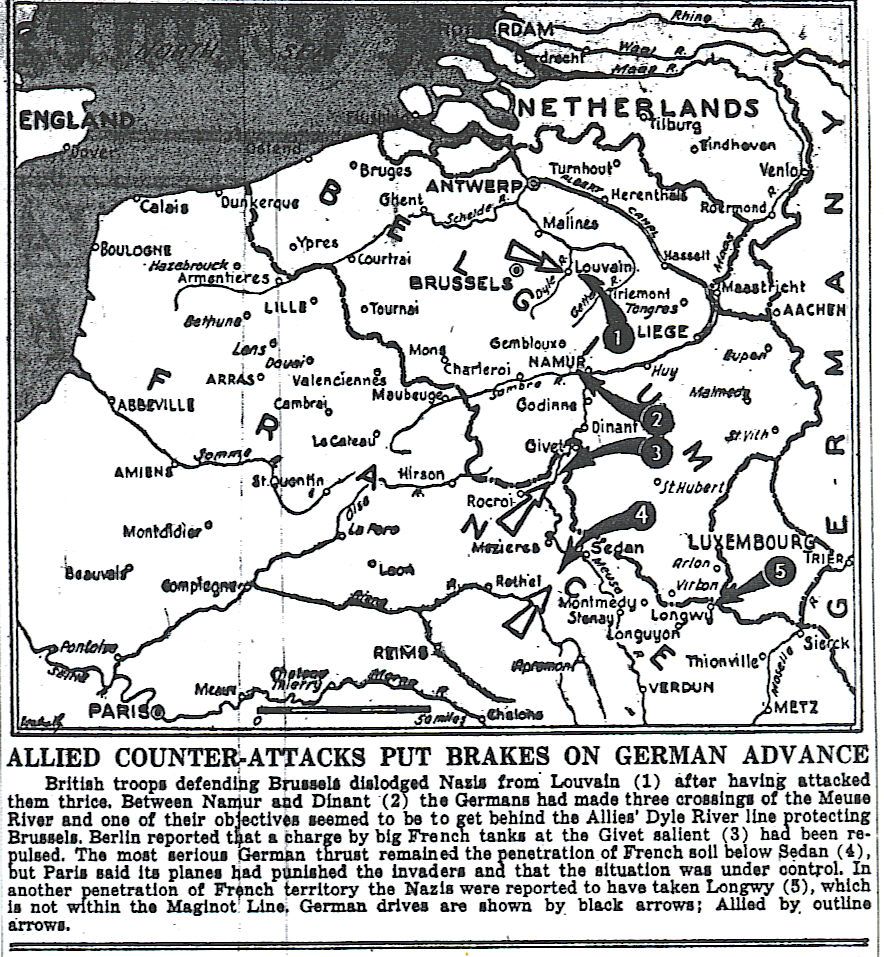
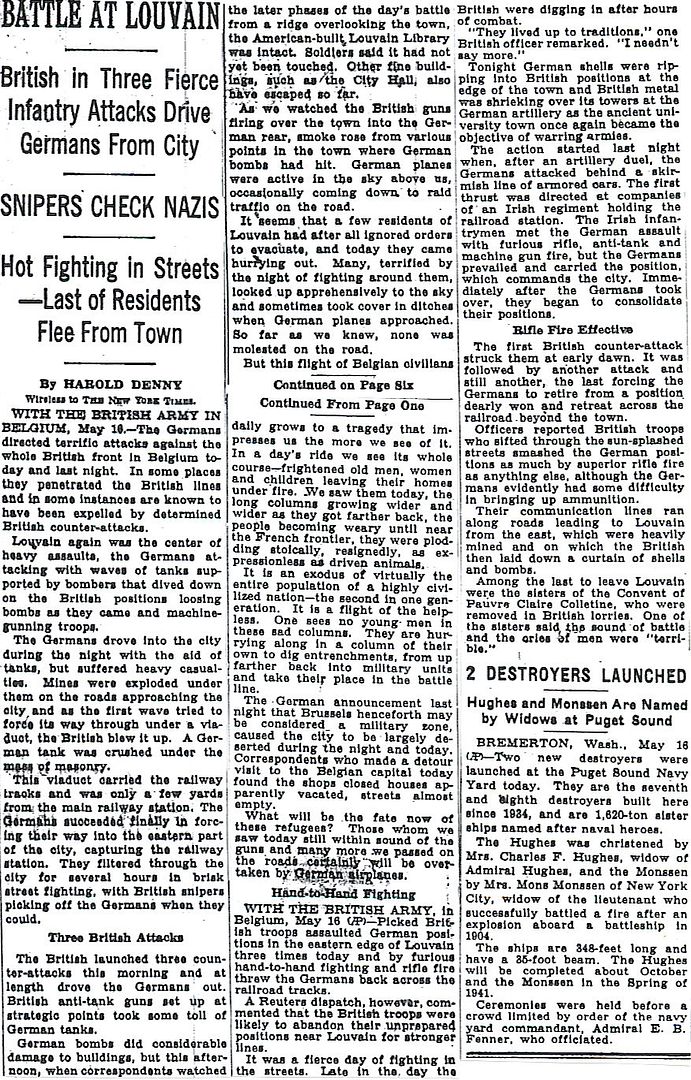
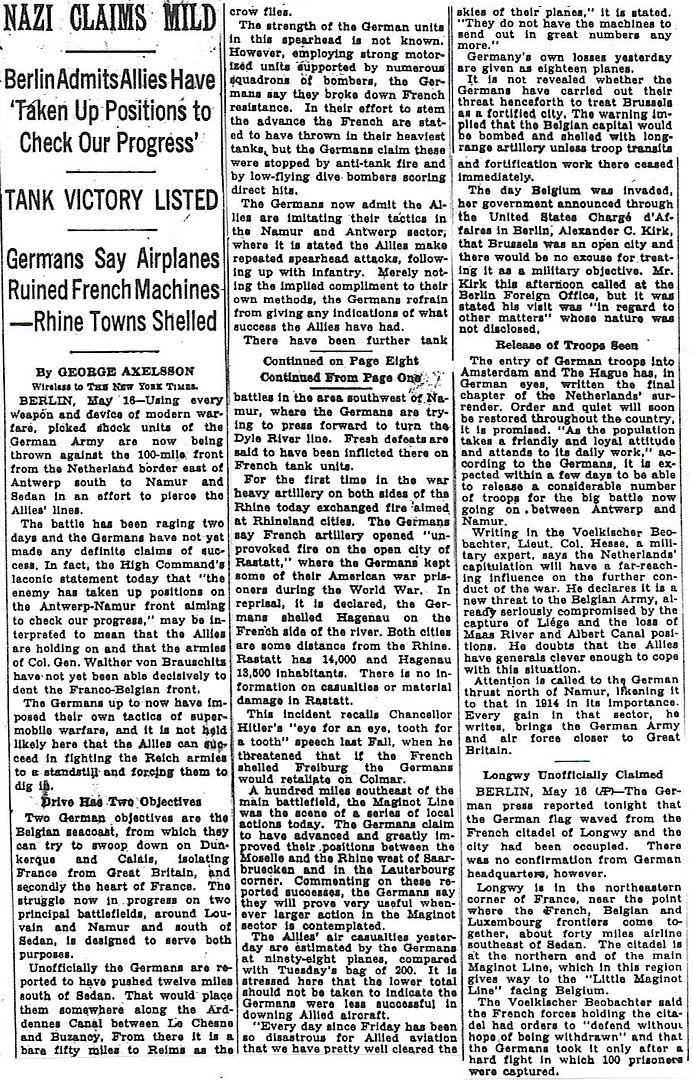
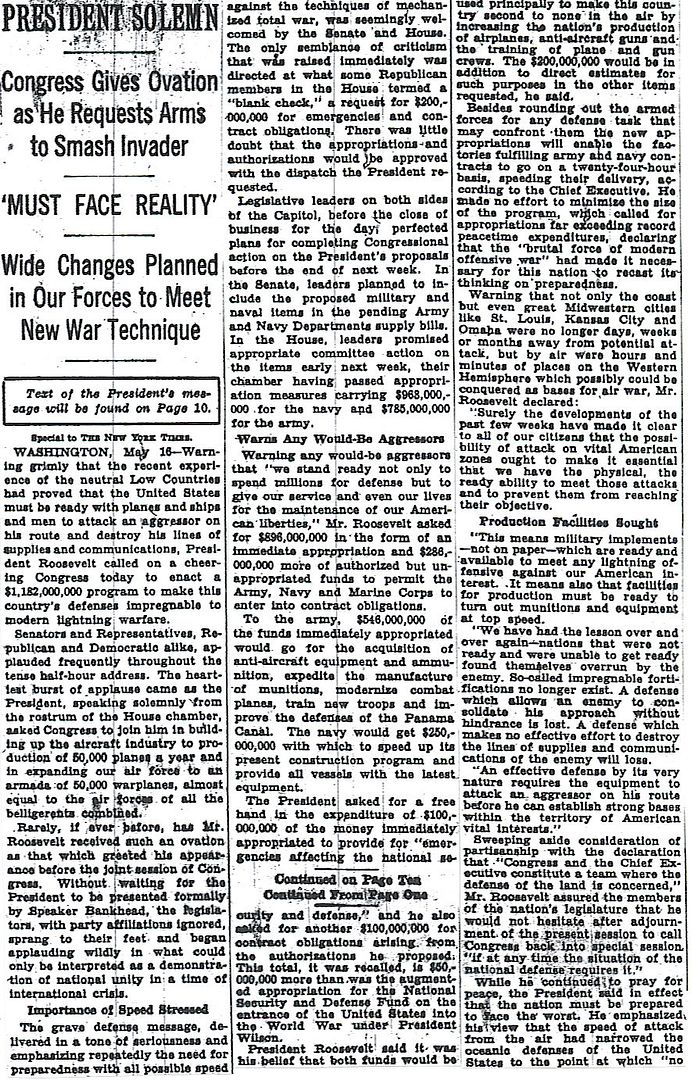
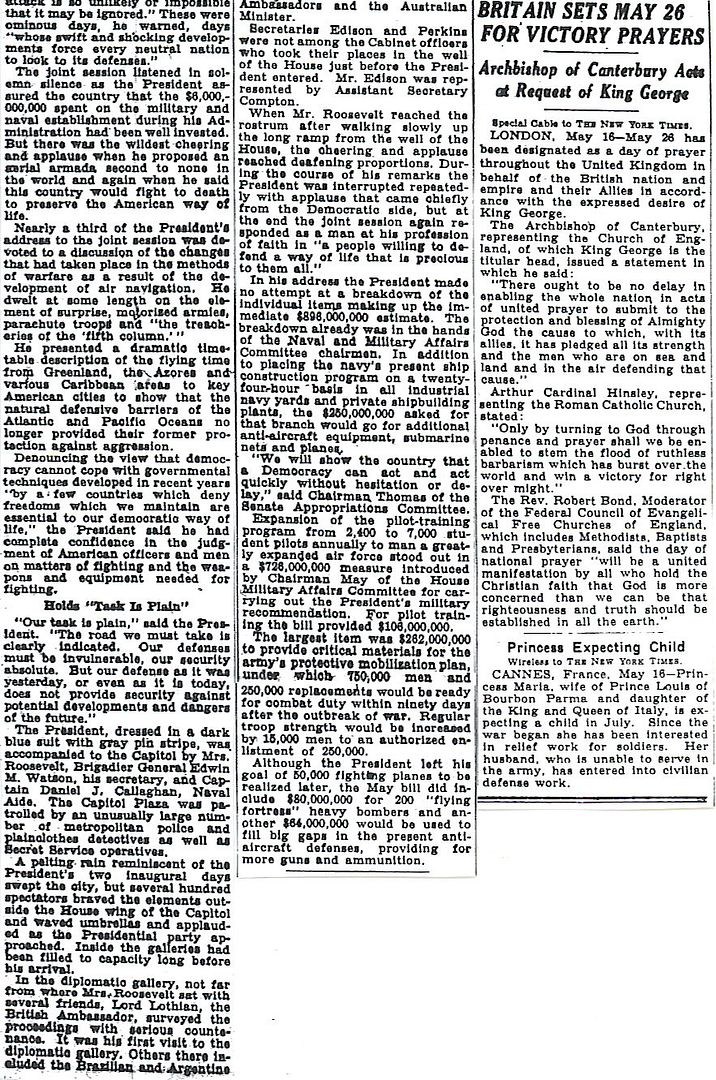
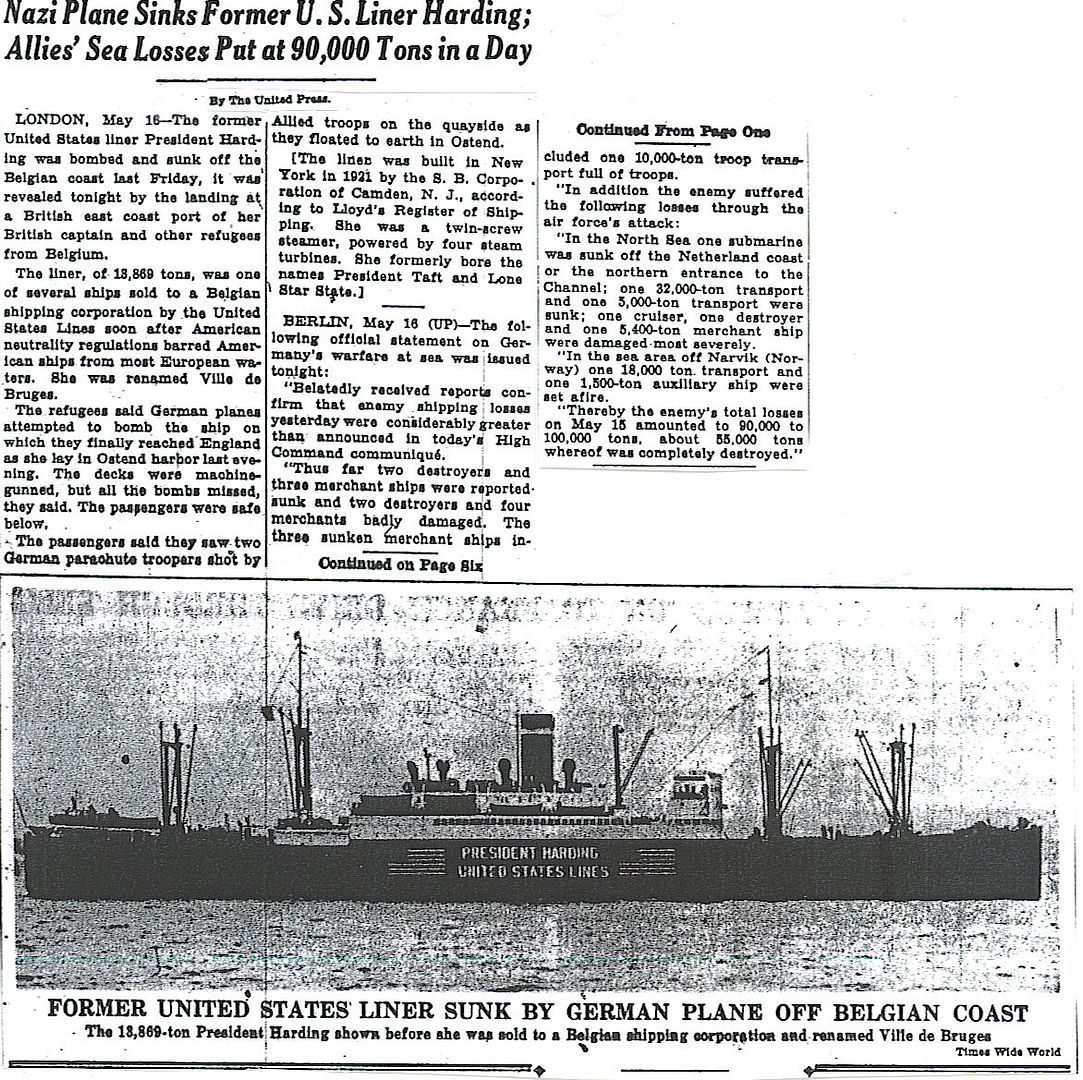
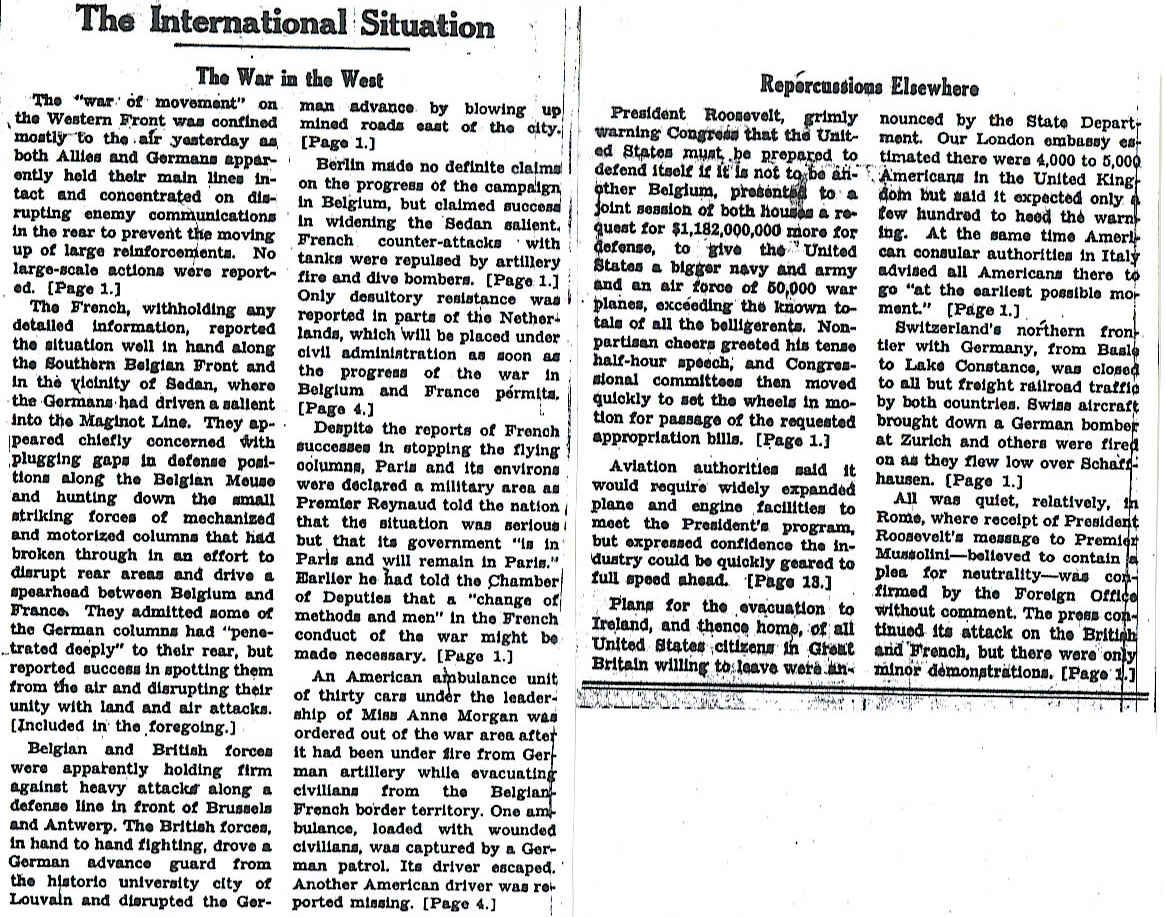
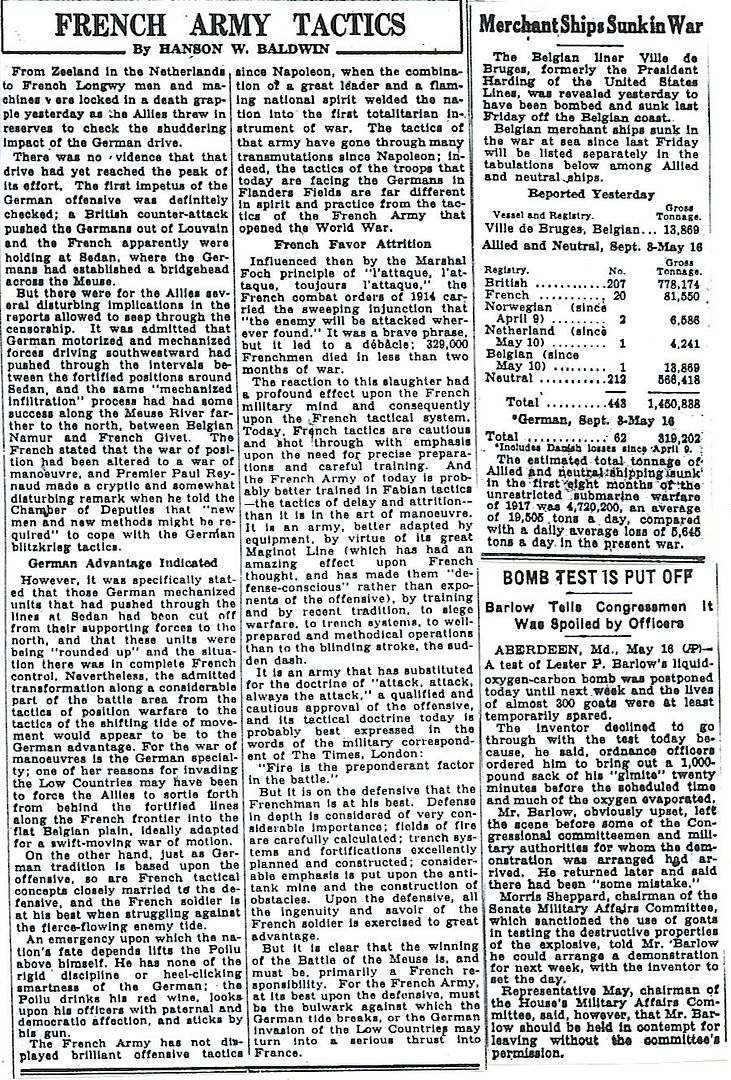
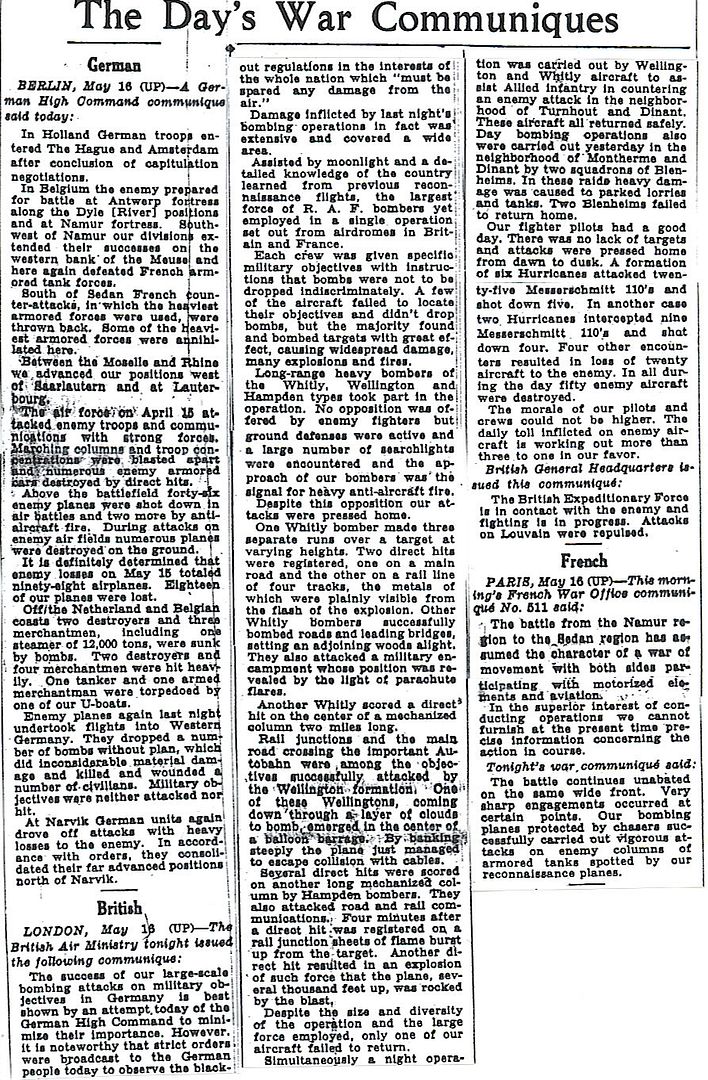
Ha! Reports were so wrong....By 17 May, Rommel had taken 10,000 prisoners and suffered only 36 losses
Ouch
he isolationists and pacifists must have been alarmed by this call for a massive build-up.
Basically the French claims of containing the breakout at Sedan are BS. Intersting article from the so-called expert.
http://www.onwar.com/chrono/1940/may40/f17may40.htm
Germans occupy Brussels
Friday, May 17, 1940 www.onwar.com
On the Western Front... Troops of the German 6th Army (Reichenau) enter Brussels. Antwerp and the islands at the mouth of the Scheldt are also being abandoned but have not yet been taken by the Germans. The British and French forces in Belgium have now fallen back to the Dendre River. General Gort is now worried by the growing threat to his right flank and rear areas and, therefore, forms a scratch force to defend this area. General Mason-Macfarlane is put in command. [He has up till now been Gort’s Chief of Intelligence. Gort can be criticized for weakening this important department at such a vital stage.] In the main German attacks Guderian’s forces, exploiting the loophole in their orders allowing reconnaissance in force, reach the Oise River south of Guise. On the German left flank, the French 4th Armored Division (Colonel de Gaulle) attacks northward from around Laon. The Luftwaffe attacks them fiercely and prevents any real gains.
In Belgium... The government has moved to Ostend.
In Norway... The British cruiser Effingham goes aground and is lost while carrying men and stores to join the forces south of Narvik.
http://homepage.ntlworld.com/andrew.etherington/month/thismonth/17.htm
May 17th, 1940
UNITED KINGDOM:
RAF Bomber Command: 4 Group (Whitley). Bombing - oil storage depot at Bremen.
10 Sqn. 14 aircraft. One crashed on take-off, 12 bombed primary target from low-level, one bombed secondary target. Severe opposition, 6 aircraft damaged by Flak.
51 Sqn. 6 aircraft. 5 bombed primary, one bombed Delmenhorst airfield and was damaged by Flak. 58 Sqn. 6 aircraft. Five bombed successfully.
2 Group: 82 Sqn ( Blenheim) 12 aircraft bombing the Gembloux gap. 11 aircraft lost to Flak and fighters.
Destroyer HMS Blankney laid down. (Dave Shirlaw)
BELGIUM:
Germany occupies Brussels, Louvain, Malines and Namur. The government of Belgium is evacuated to Ostend.
Lord Gort shores up his right flank which has been held by the Belgian Army.
FRANCE:
At dawn, Rommel and his armoured advance guard, thrust towards Landrecies. At 5.15 am the Germans enter Landrecies and make straight for the local headquarters; which they capture and then take the bridge over the Sambre.
On the upper Oise, Reinhardt’s advance-guard seizes the bridges between Hirson and Guise at about 8 am.
In the middle Oise between Guise and La Fere, posts manned by the French 2 Armoured Division were attacked at 5 am by forward elements of the 2nd Panzers, and resisted fiercely on the bridges of Moy, Bethenicourt and Mezieres. But farther to the south, the bridge of Ribemont was seized at 9am by the 1st Panzers.
Then the Panzers are halted. According to Guderian’s memoirs, this morning with his leading troops on the Oise, Von Kleist arrived by plane in a towering rage. Guderian was ordered to stop his columns at once, by the Fuhrer’s orders. he also stormed at him for having exceeded his instructions. Finally, he relieved him of his command, which he handed to his senior divisional commander. Guderian consequently sent orders to all his units to stop where they were, and handed over to General Veiel. Then by wireless he gave a full account to von Runstedt. In the afternoon the army group commander asked General List, commanding the 12th Army, to settle the quarrel. The latter went to see for himself, saw the position, re-established Guderian in his command, and even authorised him to send out “strong fighting reconnaissance patrols” on the next day, but without moving his command post. Guderian now used a succession of “advanced CP’s” to pursue his advance.
On the French side, one positive action was the counter-attack by 4 Armoured Div., under Col. de Gaulle. he had only 150 tanks, one of Char-b’s and two of R 35s. His intention was to reach Montcornet, on the Serre about 12 miles to the north., a junction of roads to Saint-Quentin, laon and Rheims, to block the German’s routes in those directions. They reached Montcornet, but the German’s were in strength on the Serre, and the unsupported tanks cannot cross it. In the evening, severely harassed by German artillery fire and continuous Stuka attacks, the group fell back to Laon, bring 130 prisoners with them.
HMT Lancastria is sunk at St Nazaire. She had been evacuating troops, and some civilians, from France. Almost 9,000 are said to have been on board when she was hit 4 times by German bombs. (Tony Scala)
NORWEGIAN CAMPAIGN:
RN: Cruiser HMS Effingham runs aground on an unseen rock in Vestfjord between Briksvaer and Terra Islands, as she carries troops to Bodo to help block the German advance on Narvik. She is later torpedoed and abandoned. The rock was marked on the chart, but at the time was obscured by a pencil line which had been drawn by the navigator. HMS Cairo, Coventry, Echo and Matabele took off the crew. She was finally destroyed by gunfire to prevent her capture by the Germans on 21 May 1940. (Dave Shirlaw and Peter Beeston)
During the evening of the 16th, HMS Ark Royal had steamed to seaward to place herself in position to cover a troop convoy enroute to Norway. After reaching position 68.08N, 07.00E, four Fighter Patrols were dispatched between 1510 and 2200 but the only excitement was caused when HMS Coventry decided to fire on her supporting aircraft!
Meanwhile, with the junction with HMS Furious and HMS Glorious at hand, Vice Admiral Wells instructed Glorious to send off one of the Walrus amphibians of 701 Squadron to communicate with him. It arrived at 1500, and then flew on to Harstad at 1700. (Mark Horan)
ICELAND: The 147 Brigade starts to arrive today to replace the occupying Royal Marines. (Dave Hornford)
U.S.A.: The USN announces that they will re-commission 35 more “four-stacker” destroyers for use on the Neutrality Patrol and to meet fleet requirements.
The motion picture “My Favorite Wife” is released in the U.S. This comedy, directed by Garson Kanin and starring Cary Grant, Irene Dunne and Randolph Scott, is about Grant’s wife (Dunne) who is supposedly dead but returns to find him married to another woman. The film was nominated for three technical Academy Awards. This film was remade in 1963 as “Move Over, Darling” with Doris Day and James Garner. (Jack McKillop)
It’s interesting to read these articles in the Times and know that they don’t accurately reflect the reality of the situation. The average American reading them will conclude there is a hard fight in France along the Meuse but that the outcome is still in doubt and the French are bringing up forces to continue the battle. The truth is, for all intents and purposes, the war is over for France. They’ve already lost.
As Homer’s maps show, the French 9th Army, responsible for holding the Meuse between Charleville and Namur, has ceased to exist. The German “lines” shown on the map aren’t really there. Instead, there is a mass of mobile panzer and motorized divisions moving west through the French rear areas. Groups of French soldiers are now isolated, static and cut off from any higher HQ and all higher level command and control has ceased. Those units will meekly surrender to the motorized units or when the marching foot infantry comes along. Some high quality armored formations will be caught “with their pants down” while refueling and be destroyed and scattered. Many of the French soldiers will be shocked to find the Germans have penetrated so far.
The op-ed about French tactics is contradicted by Premier Reynaud’s statement that they need to fight a different kind of battle. But it’s way too late to try to learn a new game plan. The French will not have the luxury of trading space for time to learn a new way of war, as will the Soviets next year.
This battle is like an arm-wrestling match. The Germans very quickly gained the upper hand and now have all the leverage. The French and British will in various places put up some determined resistance, such as at Stonne (south of Sedan), Arras and later along the Somme and Aisne rivers. But the Germans now have all the advantage and the outcome is no longer in doubt.
We have gone to war with a 1918 army against a German Army of 1939. It is sheer madness. - General Maxime Weyhand.
Weygand said this to Reynaud on May 25th. Only when it was too late did they realize the scope of their outdated tactics.
It is very interesting though to read these reports. I would think that there is an absolutely pitched battle going on right now that the French have every chance of winning. The situation on the ground is far worse that the news reports let on.
Not only is that true, but it was one of the most intense battles on the invasion of France. 10 miles south of Sedan lies the little town of Stonne. The battle report of the Infantry Regiment Großdeutschland says this of the town:
Stonne! That word has become a concept for us. The name of the mountain village was written in blood in our regimental history
The battle for the town began two days ago on the 15th, and by today the town has changed hands for the 17th and last time. The fight for Stonne really began when a disagreement on the depth of the bridgehead in the Sedan region. von Kleist felt that a bridgehead of 6 to 8 kilometers would be sufficient while Guderian insisted that it needed to be around 20 kilometers including the massif of Stonne. von Kleist was not moved and ordered his boundaries be used. Guderian was not satisfied with this though and on the 14th of May when he was being visited by Rundstedt, he asked for resolution of the matter. Rundstedt ruled that von Keist's order was binding.
Guderian decided that he was not going to head that order and on the 14th, he broke out in 2 directions. The 1st and 2nd Panzer Divisions broke west while the 10th Panzer Division moved south. In the process he pushed right into the French X Corps counterattack. This sent forces fleeing south into the position where Flavigny's XXI Corps was reading for an attack of their own. The fleeing troops caused him to decide to switch to the defensive in the region near Stonne. The Stonne massif was an ideal position as a jump off point for a northern push by Flavigny, but by the time he made the decision to position his forces there the Germans had already occupied the town. A fierce fight for the town commenced in which it exchanged hands as follows:
15 May 0800 - Germans occupy Stonne
15 May 0900 - French take town from Germans
15 May 0930 - German retakes town
15 May 1030 - French retakes town
15 May 1045 - Germany
15 May 1200 - France
15 May 1700 - Germany
16 May 0730 - France
16 May 1700 - Germany
16 May Evening - Germans pull back leaving town unoccupied overnight.
17 May 0900 - Germans reenter town
17 May 1100 - France
17 May 1430 - Germany
17 May 1500 - France
17 May 1630 - Germany
17 May 1700 - France
17 May 1745 - Germany finally take the town
Here is an incidents in this battle that really shows how much better the French equipment was. If they have had the leadership and tactics to go with it, things would have been quite different.
First the taking of the town at 0700 on the 16th of May was actually done with a single French tank. Captain Billotte, commander of the 1st Company, 41st Battalion broke through the German defensive positions in a single Char-B Eure tank. The Panzers from the 8th Panzer Regiment, charged with the defense opened up on the lone tank. The Char-B proceeded to drive directly through the column taking out all 13 of the Panzers in the town as well as two anti-tank guns. The Char-B at been hit 140 times, but not one penetrated its thick armor.
Summarized from The Blitzkrieg Legend by Karl-Heinz Frieser pp. 206-213.
That is pretty sick. Everybody hears about what that Tiger did in that Normandy town kicking the Brits arse but this is just as amazing. Considering the large number of Pz I and IIs the Germans deployed in France the Char-B was invulnerable and its guy probably went through the thin armor like a hot knife through butter.
http://worldwar2daybyday.blogspot.com/
Day 260 May 17, 1940
French 4th Armoured Division with 200 tanks including the formidable Char B (under Colonel Charles De Gaulle) attacks Guderian’s Panzer Corps at Montcornet. They take 500 prisoners but make little ground against improvised German defenses and then withdraw. German tankers are shocked by the French lack of aggression. Despite the halt imposed on the Panzers, Guderian is given permission for ‘strong reconnaissance’. He interprets this liberally and advances several km.
The dominos begin to fall in Belgium. Instead of attacking the German salient into Allied territory, British Expeditionary Force commander General Lord Gort sees the danger of encirclement in the Panzer thrust to his South and orders a retreat to the Scheldt River. This allows German 6th Army under General Reichenau to enter Brussels. Churchill, likewise worried by the panic in the French command, begins to think about saving the British Army. Churchill also considers recalling troops from Narvik.
It had to be absolutely unnerving for those German tankers. You just keep pummeling your enemy and it just has no effect. The Char-B was the heaviest armored tank in theater at the time except for the British Matilda and those 20mm guns on the Panzer II just wouldn’t do anything against 60mm of armor.
Disclaimer: Opinions posted on Free Republic are those of the individual posters and do not necessarily represent the opinion of Free Republic or its management. All materials posted herein are protected by copyright law and the exemption for fair use of copyrighted works.